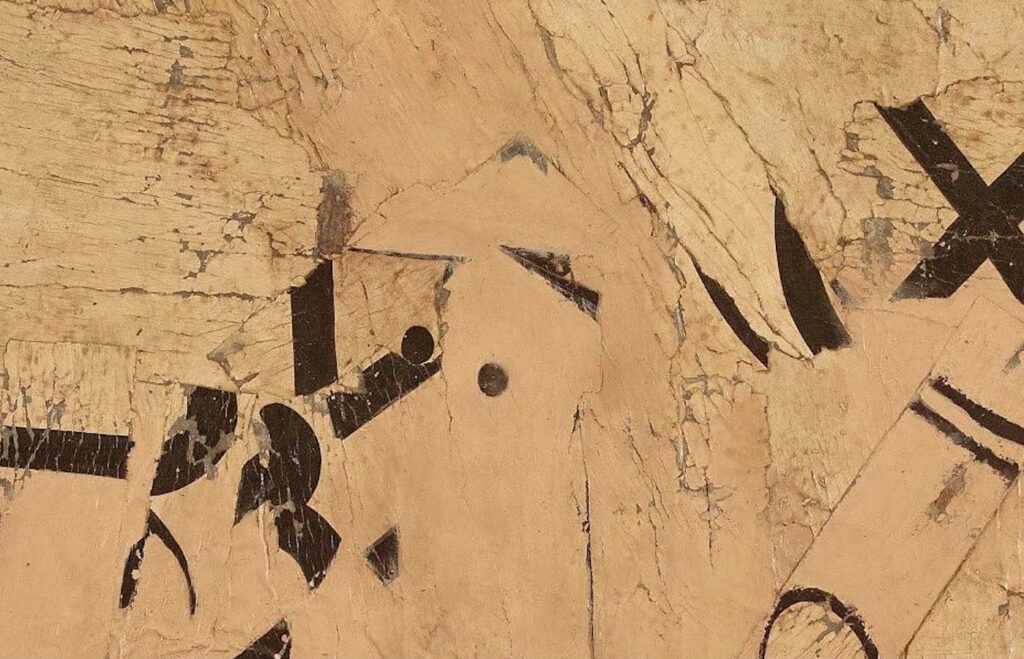.insofar gallery, Lisboa, Portugal
05 Nov 2022 - 17 Dec 2022

António Ole, e… o lixo vai?! (Detail), 2022. Courtesy of .insofar Gallery
The journey of an artist that spans over 50 years has been revealed in the intimate layers of his art on complex issues of people, stories and struggles of mutating societies, António Ole, from Caluanda, has become one of Angola’s most recognised conceptual artists in recent history: which has led to a strong rethinking of contemporary art in the African continent.
In a brief contextualisation of the landscape in which António Ole’s work takes place, it is worth recalling some social, cultural and political moments that started in the twentieth century and had significant repercussions in Africa. The first movement for the valorisation of Black Culture appeared in the USA with the Harlem Renaissance (1918), which had close involvement in organisations related to Civil Rights and Reform. Followed by others such as Pan-Africanism, Pan-Arabism, the Black Arts Movement, the Black Panther Party, Black Feminism, and even the controversial Afro French-Caribbean Negritude movement, all of which contributed towards notions of representation and definition of Black identity. An epoch of effervescent change.
The second took as its symbol the famous mask of Queen Idia reproduced by Erhabor Emokpae, one of Nigeria’s pioneers of modern art 2. FESTAC, which Antonio Ole documented in one of his films, counted with the presence of more than 17.000
participants from 50 countries and was regarded, until that date, as the largest cultural event ever held in the African continent. Yet, Angola and Portugal lived for decades in a vacuum of isolation. It was only after 25 April 1974 that they progressively became aware of the new world situation- in Angola, freedom and detachment from the values imposed by Colonialism were imperative. Later on, in 1989, the polemic contemporary art exhibition Magiciens de la Terre opened at the Georges Pompidou and the Grande Halle de la Villette, shaking the structure of Eurocentric art history: A group exhibition in which 50% of the artists were non Western and some had no formal education, some of whom are now a reference in Contemporary Art History: such as Chéri Samba, Twins Seven Seven and Esther Mahlangu.
António Ole has always been driven by his integrity and his urge to call for freedom, refusing any political office or benefits from whatever regimes – always a humanist, but never a cacique – which has until today granted him a sense of freedom and independence to which his work is an unquestionable witness.
The question e_ o lixo vai?! that gives title to his solo exhibition at the .insofar gallery denouncing precisely his creative freedom. If, on the one hand, it alludes to one of the expressions he repeatedly heard from people who perplexedly observed him collecting trash and making artworks with them, on the other hand, it refers to the variety of materials discarded by the city, which he uses, such as used and rusty iron sheets, bones, shells, saltpetre, red earth worm eaten Wood and even peeling paint from walls – taken as metaphorical materials to address themes dealing with actual memories of war, poverty, slavery, destruction, that are the Angolan people’s daily struggle, and which he has always centred its practice, as is perceptible in this exhibition.
In this cartography of the places where he lives and influences him to communicate ideas within time and space, Ole sets things against each other, gradually building a sociocultural archive of unparalleled interconnections.
In this exhibition is included the iconic Township Wall (X) created for the itinerant collective exhibition Africa Remix – Contemporary Art of a Continent (2004) curated by Simon Njamill, and later included in his retrospective António Ole: Luanda, Los Angeles, Lisbon (2016) at the Calouste Gulbenkian Foundation, co-curated by Isabel Carlos and Rita Fabiana. Today, it extends over nine metres along one of the walls at .insofar gallery.
In another work in this exhibition, Ole tackles current environmental and economic issues, using elements from the natural world to warn us of irreparable losses in pursuit of economic progress. Irefer to Boi Sagrado I – à memória de Ruy Duarte de Carvalho (Sacred Ox I – in memory of Ruy Duarte de Carvalho), a work that embodies multiple meanings. Taking this as a starting point, the film Ondyelwa: Festival of the Sacred Ox (1978), directed by his close anthropologist friend, captures in his documentary the sacred ox procession- a ritual practised by the Nyaneka Humbe.
This exhibition contributes towards a comprehension of the work of master António Ole, which provocatively shivers us from the inside of how honest it is. Curated by Inês Valle.